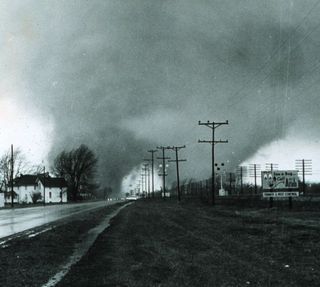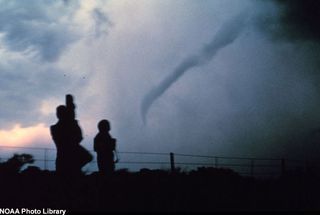40 Years Ago Today: Worst Tornado Outbreak in History

It was unusually hot in the Midwest on April 11, 1965 -- Palm Sunday. Temperatures climbed into the 80s. Storms began to develop as a strong low-pressure system sliding through Wisconsin drew warm, humid air into southern Michigan. Cooler and drier air high in the atmosphere mixed with moist, warm air near the surface.
The conditions were ripe for tornadoes.
Other single tornadoes have proved deadlier, but the outbreak 40 years ago this date was the worst in U.S. history, according to NOAA, parent organization of the National Weather Service. By the end of the day, 250 people would die and 1,500 would be injured.
The day's first twister touched down about 1 p.m. local time in Clinton County, Iowa.
By late afternoon, the storm system began to intensify over Indiana and spawned several killer tornadoes. Indiana's first tornado touched down at round 5:30 p.m., in Koontz Lake. An F4 on the Fujita scale (which runs from 1 to 5), it killed ten people and injured 180. Another tornado struck Wakarusa, Ind., and a third tripped houses to their foundations near Goshen, Ind.
The day got worse.
An 800-yard-wide monster killed 25 people near Kokomo, Ind. The storm system rolled eastward and tornadoes moved from Indiana into Ohio, wreaking havoc along the way. A double tornado was spotted near Toledo.
Sign up for the Live Science daily newsletter now
Get the world’s most fascinating discoveries delivered straight to your inbox.
Tornadoes continued to develop, and the only F5 tornado (with winds of 261-318 mph) of the day touched down near Elkhart, Ind. This famous double tornado, packing two spouts, hit the Sunnyside subdivision, killing 36 people.
High winds had taken out telephone and electrical lines, leaving residents with no way of receiving warnings of the tornado. With telephone lines down, emergency personnel in Elkhart could not warn southern Michigan communities of the danger approaching their area. Later, that would serve to alter forever the course of weather forecasting.
More tornadoes struck several counties in Michigan. Near Detroit, a mile-wide twister hit Milan.
The National Weather Service at the time was called the U. S. Weather Bureau. Its officials investigated the high number of deaths from the Palm Sunday outbreak and concluded that a primary reason was the inability to communicate warnings about the approaching storms to residents and public officials.
Shortly thereafter, the weather service launched its program of watches and warnings. Tornado Watch cautions residents when conditions are prime for tornado development, and a Tornado Warning warns that a twister is on the ground or imminent.
- Top 10 Killer Tornadoes
- Tornado Season: The Basics
- Fresh Twist on When, Where, Why Tornadoes Strike
- 2004: A Record Year for Tornadoes
Image Gallery


